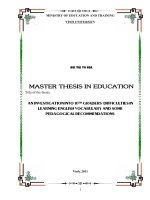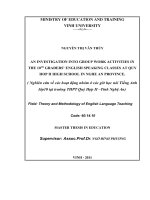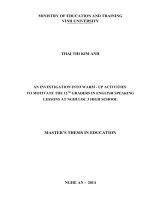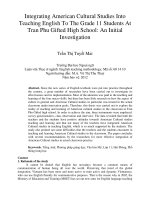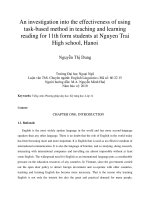AN INVESTIGATION INTO 10th GRADERS’ TEAMWORK IN PROJECT BASED LEARNING AT DAO DUY TU HIGH SCHOOL
Bạn đang xem bản rút gọn của tài liệu. Xem và tải ngay bản đầy đủ của tài liệu tại đây (3.81 MB, 184 trang )
1
MINISTRY OF EDUCATION AND TRAINING
VINH UNIVERSITY
NGUYEN THU HUONG
AN INVESTIGATION INTO 10th GRADERS’
TEAMWORK IN PROJECT-BASED LEARNING
AT DAO DUY TU HIGH SCHOOL
Field: Teaching English to Speakers of Other Languages (TESOL)
Code: 60140111
MASTER’S THESIS IN EDUCATION
SUPERVISOR: Tran Ba Tien, Ph.D
Nghe An, 2017
i
DECLARATION
To the best of my knowledge and belief, this thesis contains no material
which has previously been submitted and accepted for any other degree in any
university. The thesis is my own work and based on my own research. It
involves no material previously published or written by any other person, except
where due reference is acknowledged in the paper.
Nghe An, August 1st 2017
Author’s signature
Nguyen Thu Huong
ii
ABSTRACT
iii
The study presents an attempt to investigate Teamwork and its impacts on
the subsequent individual presentations in Project-based Learning. English for
specific purposes has been taught in high schools in Vietnam for several years
and it partially meets student’s needs. Especially, since the new pilot textbooks
with compulsory project lessons were used, it has been a challenge for both
teachers and learners to find the best ways to carry out projects. Besides, it
seems that very little research has been implemented on applying Teamwork in
Project-Based Learning in teaching and learning project lessons. The objective
of this study is to investigate the attitudes of students and teachers at Dao Duy
Tu High School about applying TW in PBL. Three tools of data collection which
were employed in this study are a questionnaire for 90 tenth-grade students and
8 English teachers; ethnographic in-depth interview and classroom observation.
All of the data received was analyzed in charts, tables or summarized
interpretively. The results of the study show that both students and teachers at
Dao Duy Tu High School think that applying TW in PBL is a fairly interesting,
necessary and effective method in project lessons. This suggests that the use of
TW in PBL is recommended to be further applied for English lessons.
Key words: Team, Teamwork, Project-Based Learning, Project-Based
Teaching, Team Project-Based Learning.
ACKNOWLEDGEMENTS
iv
I would like to express my gratitude to all those who have given me great
assistance in the completion of my research work.
First and foremost, I would like to express my deepest gratitude to my
supervisor Tran Ba Tien, Ph.D, who has provided me with insightful discussion,
helpful comments, valuable support in the preparation and completion of this
thesis. Had it not been for his supervision, the thesis would not have been
completed.
Secondly, my sincere thanks also go to all lecturers and staff of
department of foreign languages of VINH UNIVERSITY for their valuable
lessons and precious assistance. Thanks to their lessons as well as needed helps,
I could overcome enormous obstacles during the course of study.
I also wish to acknowledge the cooperation of my eight colleagues and 90
tenth-form students at Dao Duy Tu High School in contributing to the data
collection presented in this study. Without their precious support, the thesis
would not have taken shape.
Last but not least, the support extended to me by the members of my
family has been immeasurable. I would like to express my thanks to my parents,
my husband and my children for their whole hearted encouragement.
v
TABLE OF CONTENTS
ABSTRACT.............................................................................................................ii
ACKNOWLEDGEMENTS...................................................................................iii
LIST OF ABBREVIATIONS................................................................................vii
Table 2.1: The major different factors between team and group..............................17
Table 2.2: Characteristics of an Effective Team.......................................................24
Table 2.3: Advantages and disadvantages of team size............................................29
Figure 2.1: Stages of a team development...............................................................40
Figure 2.2: The teachers’ role on PBL.....................................................................57
Figure 2.3: The learners’ roles on PBL....................................................................60
2.4. Research on Teamwork.....................................................................................66
Table 3.1: Students’ profiles....................................................................................76
Table 3.2: Teachers’ profiles....................................................................................77
Figure 4.1: Teachers and students’ perception towards the necessity and importance of
PBL.................................................................................................................. 83
Figure 4.2: Students’ attitude towards TW in PBL..................................................85
Figure 4.3: Teachers’ attitude towards TW in PBL..................................................85
Figure 4.4: Students’ opinion of using TW in PBL in future...................................86
Figure 4.5: Extent of using TW in PBL in future of the teachers.............................89
Figure 4.6: Students and teachers’ attitude towards the real effectiveness of TW in PBL
......................................................................................................................... 90
Figure 4.7: Students and teachers’ attitudes towards...............................................91
the extent of developing individual strength of TW in PBL....................................91
Figure 4.8: Students’ view.......................................................................................92
Figure 4.9: Teachers’ views.....................................................................................94
Figure 4.10: Student’ difficulties in teamwork in PBL............................................96
Figure 4.11: Teachers and students’ solutions for doing project assignments........101
vi
Figure 4.12: Students’ solutions for promoting individual strengths in Teamwork in
PBL................................................................................................................103
Figure 4.13: Teachers’ solutions for promoting individual strengths in Teamwork in
PBL................................................................................................................104
APPENDIX 3.........................................................................................................15
APPENDIX 4.........................................................................................................20
APPENDIX 6.........................................................................................................27
APPENDIX 7.........................................................................................................28
APPENDIX 8.........................................................................................................29
APPENDIX 9.........................................................................................................30
APPENDIX 10.......................................................................................................35
APPENDIX 11........................................................................................................36
APPENDIX 12.......................................................................................................38
APPENDIX 13.......................................................................................................41
APPENDIX 14.......................................................................................................44
vii
LIST OF ABBREVIATIONS
DDT (High School):
Dao Duy Tu (High School)
FLT:
Foreign Language Teaching
PBL:
Project-based Learning
PBLT:
Project-based language teaching
TW:
Teamwork
TPBL:
Team Project-based Learning
viii
LIST OF TABLE
ABSTRACT.............................................................................................................ii
ACKNOWLEDGEMENTS...................................................................................iii
LIST OF ABBREVIATIONS................................................................................vii
Table 2.1: The major different factors between team and group.......................17
Table 2.2: Characteristics of an Effective Team..................................................24
Table 2.3: Advantages and disadvantages of team size.......................................29
Table 3.1: Students’ profiles..................................................................................76
Table 3.2: Teachers’ profiles..................................................................................77
APPENDIX 3.........................................................................................................15
APPENDIX 4.........................................................................................................20
APPENDIX 6.........................................................................................................27
APPENDIX 7.........................................................................................................28
APPENDIX 8.........................................................................................................29
APPENDIX 9.........................................................................................................30
APPENDIX 10.......................................................................................................35
APPENDIX 11........................................................................................................36
APPENDIX 12.......................................................................................................38
APPENDIX 13.......................................................................................................41
APPENDIX 14.......................................................................................................44
ix
LIST OF FIGURES
ABSTRACT.............................................................................................................ii
ACKNOWLEDGEMENTS...................................................................................iii
LIST OF ABBREVIATIONS................................................................................vii
Figure 2.1: Stages of a team development............................................................40
Figure 2.2: The teachers’ role on PBL..................................................................57
Figure 2.3: The learners’ roles on PBL................................................................60
Figure 4.1: Teachers and students’ perception towards the necessity and
importance of PBL................................................................................................83
Figure 4.2: Students’ attitude towards TW in PBL.............................................85
Figure 4.3: Teachers’ attitude towards TW in PBL............................................85
Figure 4.4: Students’ opinion of using TW in PBL in future..............................86
Figure 4.5: Extent of using TW in PBL in future of the teachers.......................89
Figure 4.6: Students and teachers’ attitude towards the real effectiveness of TW
in PBL..................................................................................................................... 90
Figure 4.7: Students and teachers’ attitudes towards.........................................91
the extent of developing individual strength of TW in PBL...............................91
Figure 4.8: Students’ view.....................................................................................92
Figure 4.9: Teachers’ views...................................................................................94
Figure 4.10: Student’ difficulties in teamwork in PBL.......................................96
Figure 4.11: Teachers and students’ solutions for doing project assignments. 101
Figure 4.12: Students’ solutions for promoting individual strengths in Teamwork
in PBL................................................................................................................... 103
x
Figure 4.13: Teachers’ solutions for promoting individual strengths in Teamwork
in PBL................................................................................................................... 104
APPENDIX 3.........................................................................................................15
APPENDIX 4.........................................................................................................20
APPENDIX 6.........................................................................................................27
APPENDIX 7.........................................................................................................28
APPENDIX 8.........................................................................................................29
APPENDIX 9.........................................................................................................30
APPENDIX 10.......................................................................................................35
APPENDIX 11........................................................................................................36
APPENDIX 12.......................................................................................................38
APPENDIX 13.......................................................................................................41
APPENDIX 14.......................................................................................................44
1
CHAPTER 1: INTRODUCTION
1.1. Rationale
Language has long been considered as a means of communication among
people. It has not only been viewed as a means of thinking but also as a means
of transferring culture from one country to another as well as from one
generation to another. Therefore, many countries focus on teaching languages
more than teaching the native language to its citizens. Speaking at a conference,
Deputy Minister of Education and Training, Nguyen Vinh Hien, (2011)
confirmed that National Foreign Language Project 2020 (usually called Project
2020) aimed: By 2020, the majority of young people graduating from Vietnam
secondary schools, colleges and universities will have had the capacity to use
language independently; confidence in communicating and learning to work in
an environment of integration, multi-lingual, and multi-cultural. Language
experts have noted positive changes in teaching and learning foreign languages
in recent times, especially English. Students learn English more naturally,
interestingly and dynamically.
2
At present, English is an international language. In the trend of
globalization, the importance of English can not be denied and ignored because
it is widely used all over the world. Along with the development of science,
technology, and education, English plays the most important role in all fields.
English has become more dominant around the world. In some countries it is
used as the mother tongue and other countries learn it as second language in
their schools. This makes English widespread. In addition, many reasons which
contributed to rising of English spreading, for example, use it for
communication between people around the world, as well as, it is language of
modern times. There is no doubt that English is the language of communication
between the people with different cultures. Therefore, English has become a
major foreign language in most countries which do not use English as their
mother tongue or second language, including Vietnam.
3
Identifying the importance of English in global integration, English has
been taught in education system for a long time and it has been identified as a
core subject that is used in all important exams such as final exams, entrance
exams to high school, college or university. Nowadays, it has become widely
accepted that “communicative competence should be the goal of language
education, central to good classroom practice” (Savignon, 1997). Thus, in their
research on factors that contribute to success in English teaching, Davies and
Pearse (2000) stated, “The main test for real success in teaching and learning
should be whether or not the learners can communicate at all in English”. With
this trend, according to the Ministry of Education and Training of Viet Nam,
contemporary education needs to emphasize student-centered teaching. In this
case, teachers play the roles of instructors, organizers, observers, assistants and
advisers who help students develop their sense of creativity, problem-solving
skills, and self-studying during the process of learning. Students are learning in
an active and creative way and have the opportunity to promote both
independent ability and interactive ability well.
4
To meet the trends and new teaching requirements, along the years, many
different active teaching methods have been applied and developed but we
wonder whether they face students’ needs or match the requirement of a new
administration. Direct method, task-based language teaching, content-based
instruction, audio-lingual method, total physical response are all claimed to be
the active options to teach English. (Stryker and Leaver, 1993; Brown, 1994;
Willis, 1996; Singh, 2001) Since the new set of textbooks from Tiếng Anh 3 to
Tiếng Anh 12 were designed and used in school education system, Project-Based
Method is being attracted the teachers and students’ attention because the format
of this new textbook is completely different from the old one. The most
remarkable feature in this new textbook is the “Projects” section. It is designed
to apply the Project-Based Learning approach which is learner-centered.
Significant role of students is selecting the content areas and nature of the
projects that they do. It means that students understand what they are doing, why
it is important, and how they will be assessed. Indeed, students may help to set
some of the goals which they will be assessed on, and understand how they will
be assessed over these goals. All of these learner-centered characteristics of
Project-Based Learning (PBL) contribute to learners’ motivation and active
engagement.
5
In fact, when teaching both present textbooks and new pilot textbooks, the
author identifies that it is not easy for students to carry out “Projects” and most
of the teachers have difficulties in implementing the new teaching method. The
problem here may be due to three main reasons. Firstly, most of the teachers are
still familiar with their traditional methods of teaching, according to which the
organizing teamwork and giving students the autonomy in doing their duties
make teachers worried or even think that students cannot achieve their learning
goals. Moreover, some teachers doubt on the effectiveness of the
implementation of PBL, especially the development of skills, independence and
creativity of students. They said that teamwork in projects only focuses on the
strong and active students. Weak students will increasingly lack attempts in
learning. As a matter of fact, some of the students may lack motivation and
interest when doing projects. Secondly, most of the projects are performed under
teamwork or groupwork forms but not all the students have the same capacity
level and different students have different purposes of learning English. The
outcome of each group or team is affected by many different reasons, including
objective and subjective reasons. The consequence seen from that is some
groups or teams have effective work while some others do not. Thirdly, the key
problem that the author is paying attention to is that there is no clear distinction
between team and group activities. This leads to the consequence that many
teachers do not organize team activities well, which makes the implementation
of the project bring students many difficulties. In literature review, there are few
studies about the attitudes of students toward teamwork. Therefore, the author
has always taken the grave concern about these questions “How are teachers
and students aware of the importance of PBL?”, “How much does Teamwork
(TW) have affect on PBL?”, and “How can teachers develop the students’
individual strength by taking TW in PBL?”
6
In literature review, a large number of educators and researchers have
performed numerous studies on PBL. However, most of them only focus on
analyzing the advantages, limitations and features as well as application of PBL
method in teaching to improve the quality of training. The teachers who have
been applying PBL in teaching all understand that there are many ways to
implement PBL such as individual activities, group activities, team activities or
community activities. Even so, many teachers do not understand about the
important features of teamwork as well as the importance of organizing TW in
PBL, which affects the activity effectiveness of students. The author found that
few studies on TW in PBL have been carried out. Besides, in some researches,
Gardner and Korth (1998) and Scarafiotti and Klein (1994) found that even
though the results were not statically significant, students’ attitudes changed
positively after their participation in teams. Meanwhile, according to Porter
(1993), McCorkle et al. (1999) and Buckmaster (1994), students’ experience
with teamwork made them frustrated. In spite of the students’ perception toward
teamwork is improved, some still prefer to work individually or are less active in
teamwork.
For the above-mentioned reasons, the author of this paper would like to
conduct the research entitled “An investigation into 10th graders’ Teamwork
in Project-Based Learning at Dao Duy Tu High School” with the ambition
that this will bring certain benefits of using teamwork to increase students’
motivation in carrying out projects in learning English. Also, it is the author’s
wish that this short and limited study will be of some help to those who are
really interested in Project-based Language Teaching (PBLT), and it will make a
contribution to the process of teaching and learning English in the Project 2020.
1.2. Aims of the study
7
In this paper, the author intends to study the attitude, awareness and
perception of teachers and students toward Project-Based Learning, especially
the application of Teamwork in Project-Based Learning.
This study is undertaken to find out the difficulties that students at grade
10 of Dao Duy Tu High School (DDT High School) are facing when applying
TW in PBL in English classes; find the best ways to minimize the students’
difficulties in taking TW in PBL.
The study, furthermore, aims at helping the author know whether the
application of TPBL in English classes can arouse students’ interest or
motivation in learning English. Through the survey, the most effective and
appropriate solutions to raise the students’ individual strength in Team Projectbased Learning will be mentioned.
1.3. Research questions
From the aims established above, this research is conducted to find the
answers for the three following questions:
(1) What is the teachers and students’ perception towards Teamwork in
Project-Based Learning at Dao Duy Tu High School?
(2) What are the common problems encountered by 10th graders in doing
project-based tasks at Dao Duy Tu High School?
(3) How to maximize students’ individual strengths in preforming Team
Project-Based Learning?
1.4. Scopes of the study
8
To find the answers to the three above-mentioned research questions, the
experiment has been carried out among ninety 10 th-form students in classes
10D1 and 10D2 in Dao Duy Tu high school. The most characteristic of these
students is that their age group ranges from 15 to 16. Almost all students here
have been learning English since at least grade 3. Therefore, their knowledge of
English is fairly good. This helps them easily to finish their projects on time and
present their final products in a persuasive way.
Besides, this study also conducted a survey on the attitudes and awareness
of eight English teachers who are teaching at DDT High School about the role
and effectiveness of the PBL as well as their evaluation on TW in PBL. The
results of the evaluation on this issue will help many other English teachers get
an objective view of PBLT. Also thereby, researchers and educational
administrators can have more appropriate measures to promote the development
of language learning and teaching.
1.5. Research methods
Both quantitative and qualitative methods are employed to carry out the
study. That is, the data serving the research analysis and discussion were
collected by means of:
- Classroom observation
- Questionnaires
- Ethnographic in-depth interview
Besides, reviewing the related document is also a method to establish the
theoretical background of the study, which mainly focuses on Teamwork,
Project-based Learning and Team Project-based Learning.
1.6. Design of the study
The study consists of five chapters:
9
- Chapter 1: Introduction gives out the fundamental reason why I choose
topic and it contains rationales, aims, methods, scope and design of the study.
- Chapter 2: Literature Review establishes the basic theoretical
backgrounds from the literature on classes, teaching techniques which are focus
on the theoretical background of three issues:
The first issue is about teamwork, types of teamwork, advantages and
disadvantages of teamwork, successful teamwork as well as its implication in
English language teaching.
The second issue is about PBL in which definition, strengths, challenges
and its procedure are mentioned.
The third issue is about Teamwork and PBL in Foreign Language
Teaching (FLT) with some effective strategies.
- Chapter 3: Methodology describes the overall picture of how the
research was carried out from the fist step of determining the research design to
the last step of gathering the results. This is composed of the subjects or
participants and data collection method. This chapter ends with the procedure of
the research.
- Chapter 4: Findings and discussions reveals the findings drawn through
analyzing the collected data and opinions. Based on this analysis, the discussion
of the research questions was conducted.
- Chapter 5: Conclusion summarizes the key findings made from the
study, practical implications, limitations of the study and suggestions for further
research.
10
CHAPTER 2: LITERATURE REVIEWS
This chapter consists of three sections. Section one (1) concerns key
concepts related to the study of Teamwork as well as identifying the difference
between team and group. It shows the advantages and disadvantages of using
Teamwork and highlights the crucial elements of successful teamwork. Section
two (2) gives some issues of the definition of project and Project-Based
Learning. Section three (3) introduces some effective ways to apply TW in
PBLT or PBL, which is suitable for English classes.
2.1. Teamwork
2.1.1. The difference between team and group
2.1.1.1. The definition of team
Many different definitions of teams have been mentioned in the studies of
researchers and educators. However, the definition of a team commonly involves
an alliance of three or more individuals who collaborate and work
interdependently to achieve a mutual goal or objective over the course of a given
project, focus, or agenda (Fritz, 2014, p1).
In a more functionalistic sense, teams are defined as follows: they “are
composed of individuals who work together in close proximity with each other
and who interact with other teams in the workplace.” (Ingram, et al, 1997, p125)
Teams are affected by environmental issues and changes including economy,
organization and needs of customers (Ingram, et al, 1997; Stevens & Campion,
1999). According to Belbin (1993), teams are characterized by a limited size, a
crucial selection and leadership which is shared or rotated. Furthermore, teams
are following a role spread and coordinated style as well as a spirit of dynamic
interaction (Belbin, 1976; Belbin, 1993¸ Salas, et al, 2000, Mullin, 2002). Teams
are seen as an open system which interacts between inputs and outputs to
accomplish a given task (Ingram, et al, 1997; Plovnick, Fry & Rubin, 1975)
11
On the other hand, a team is a group of individuals working towards
common goals (Beckhard, et.al. 1977). In addition, a team is a complex entity
with an identity and a culture. Teams, who are the most effective in achieving a
goal, commit to a constant process of team building and developing
cohesiveness (Briggs, 1997).
To sum up, a team consists of two or more individuals. It is set up to
accomplish a goal and existed for certain purposes. A team usually has a team
leader who will give ideas and make plan for the team. Team leader will assign
tasks to each person in the team to match the capabilities and speed of each team
member. In a team, all members have to interact with each other and make unity
with each other.
2.1.1.2. The definition of group
There have been a variety of ways to define a group because groups are a
fundamental part of social life. In classes, group can be understood as a number
of people or things that are together or in the same place; a number of people
who are connected by some shared activity, interest, or quality; a number of
things that are related in some way. However, while there are some very
different ways of defining groups – often depending upon which aspect of them
that commentators and researchers want to focus upon – it is worthwhile looking
to a definition that takes things back to basics. Donelson R. Forsyth (2006)
defined of a group as “two or more individuals who are connected to one
another by social relationships”. This definition has the merit of bringing
together three elements: the number of individuals involved, connection, and
relationship.
12
A group, in theory, represents three or more individuals who, although
aligned according to similar objectives or a similar unit assignment, work and
perform independently of each other to achieve organizational goals (Fritz,
2014). A group consists of two or more individuals who share common interests
or characteristics and whose members identify with each other due to similar
traits. Accordingly, we can understand that the Group is group of people,
animals or objects that are gathered together randomly or intentionally. They can
be under certain criteria, such as age, gender, preferences.
As researchers turned to the systematic exploration of group life, different
foci for attention emerged. In a famous piece, Lewin wrote, “it is not similarity
or dissimilarity of individuals that constitutes a group, but interdependence of
fate” (op. cit.: 165). In other words, groups come about in a psychological sense
because people realize they are “in the same boat” (Brown 1988, p28). However,
even more significant than this for group process, Lewin argued, is some
interdependence in the goals of group members. To get something done it is
often necessary to cooperate with others.
2.1.1.3. The major different factors between team and group
13
All teams or groups vary to some extent along the five dimensions, and
there is no specifiable point at which a “group” becomes a “team” (Morgeson,
Lindoerfer, and Loring, 2010). Differences tend largely to be of degree rather
than of nature (Guzzo and Dickson, 1996) and in many ways the terms can be
used interchangeably. However, as be mentioned above, “A team is a small
group of people with complementary skills and abilities who are committed to a
common goal and approach for which they hold each other accountable”. In
teams, members share roles and responsibilities and constantly develop new
skills to improve the team’s performance. Most importantly, teams hold their
members accountable. When they experience conflict with a member, they speak
to that member directly rather than to a supervisor. When a member is not
performing to the level required, the team addresses the performance problem.
Completely different in considering a group functions, a group can be
defined as a small group of people with complementary skills and abilities who
are committed to a leader’s goal and approach and are willing to be held
accountable by the leader. A group supports the leader’s goals and the leaderdominated approach to goal attainment. A group drives individual accountability
rather than shared accountability. Leadership is predominantly held by one
person rather than the shared, fluid leadership on a team. In a group, the
dominant viewpoint is represented; in a team, multiple, diverse viewpoints are
represented. Decisions in a group are made by voting or implied agreement;
decisions on a team are typically made by consensus.
For these above elements, it is easy to see that teams and groups differ in
five key ways: task orientation, purpose, interdependence, formal structure,
and familiarity among members. They can be considered for the following
major different factors:
14
First: A leader dominates and controls a work group, while in a team, the
leader is a facilitator. In a work group, a leader usually dictates how the work
group should run and function. All direct reports will look to the leader for
direction and decisions. In a team however, a leader facilitates the discussions
with the team members. Each member’s input is taken into consideration and
made part of the final decision.
Second: The goal of a work group is often set by the leader or the head of
the organization, while in a team; the members usually set the goals. An
organization often has pre-determined goals that the work group adopts as a part
of their plan, but a team comes together to decide on their shared goals and
objectives.
Third: In a work group, the leader is obvious and he conducts the meeting;
while in a team, the members are often actively participating in the discussions.
In a work group, members often just give “yes” or “no” answers to the leader in
the meeting or at most some minor suggestions because the meetings are usually
a relay of information. In a team, members are often actively participating and
discussing about the issues at hand, offering their input spontaneously. This
often creates a synergistic solution for many problems as the issue is seen from
different perspectives.
Fourth: In a work group, the leader assigns work to the members, while in
a team, everyone decides together on the work assignments. Work is usually
decided from the top-down in a work group; roles and responsibilities are clearly
defined and each individual knows what their function is. In a team, the work is
usually decided collectively, and then the work is distributed accordingly to each
individual strengths, abilities and competence areas.
